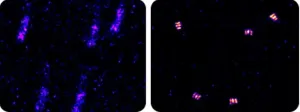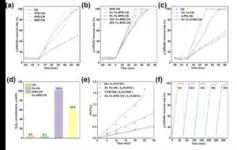(Press-News.org) When trying to measure molecular structures with nanometer precision, every bit of noise shows up in the data: someone walking past the microscope, tiny vibrations in the building and even the traffic outside. A new processing technique removes noise from optical microscope data in real time, allowing scientists to track individual molecules over 10 times more precisely than was possible before.
A team of bioengineering researchers at the University of Illinois Urbana-Champaign has introduced an algorithm called adaptive intersection maximization, or AIM, that removes high-frequency noise from super-resolution optical microscope data much faster than standard methods and results in much higher image resolutions. The algorithm will enable scientists to study chemical and biological systems far more easily and precisely than was possible before. This research was published in the journal Science Advances.
“At first, we just wanted to develop a fast algorithm because our lab produces too much data for traditional algorithms to handle, but we found that AIM can also achieve sub-nanometer precision, which is unheard of in our field,” said Hongqiang Ma, a research professor of bioengineering and the study’s lead author. “In addition, it doesn’t require immense computing power like traditional tools. It can run on a laptop. We want to make this a plug-and-play tool for all microscope users.”
In recent decades, the single-molecule localization microscopy technique has enabled scientists to visualize molecular-scale structures, surpassing what was thought to be a fundamental limitation of optical microscopes. However, it is limited in practice by uncontrollable noise, or “drift,” that essentially blurs the images and prevents super-resolution microscopy from reaching its highest resolution.
“Single-molecule localization actually uses a fairly simple instrument, but the tricky part that really impacts image resolution is drift,” said Yang Liu, a bioengineering professor and the project lead. “Many researchers only remove low-frequency drift. Removing the high-frequency drift – minute vibrations caused by environmental noise – is computationally intensive and requires large amounts of time and resources.”
Standard methods for removing drift are based on the mathematical correlations between image frames. According to Liu, the microscopes in her laboratory generate such a large volume of image data that image correlation methods take days even with supercomputing resources.
AIM also compares adjacent frames, but it proceeds by putting each data point at the center of a circle (defined by localization precision) and looking for points inside that circle in other frames. Overlapping points within the “radius of intersection” are condensed into a single localization. Then, the process is repeated once more with the condensed points. These steps use minimal computational resources, and they are faster than the acquisition time of a microscope camera. So, drift-corrected images can be produced in what is effectively real time.
The researchers tested AIM using both simulated data and structures called DNA origami that have well-defined features. The algorithm successfully localized the structures, and the degree of precision, less than 1 nanometer, turned out to be much higher than standard image correlation methods, about 10 nanometers.
Liu’s laboratory will incorporate AIM into high-throughput microscopy techniques being developed for enhanced disease detection. However, Liu also believes that the algorithm will find uses throughout biology and bioengineering. “It’s a fast and easy-to-use tool, and we want to make it widely accessible for the entire community,” she said. “We are making our software publicly accessible. We want people to get the boost in their image resolution just from this one bit of post-processing.”
The study, “Towards drift-free high-throughput nanoscopy through adaptive intersection maximization,” is available online. DOI: 10.1126/sciadv.adm7765
Maomao Chen of the University of Pittsburgh and Phuong Nguyen of Illinois also contributed to this work.
Liu is also affiliated with the department of electrical & computer engineering and the Cancer Center at Illinois. Ma and Nguyen are also affiliated with the Beckman Institute for Advanced Science and Technology at Illinois.
Support was provided by the National Institutes of Health.
END
AIM algorithm enhances super-resolution microscope images in real time
2024-05-29
ELSE PRESS RELEASES FROM THIS DATE:
Rice researchers uncover surprising role of opioid receptors in gut development
2024-05-29
Researchers at Rice University have revealed a previously unknown function of opioid receptors in the development of the enteric nervous system (ENS), often referred to as the “brain in the gut.” This discovery challenges conventional understanding of opioid receptors, shedding new light on their significance beyond pain management and addiction.
Led by Rosa Uribe, an assistant professor of biosciences at Rice and a Cancer Prevention and Research Institute of Texas (CPRIT) Scholar, the research team identified the genes critical for ENS development by conducting a series of experiments using zebrafish ...
Cleveland Clinic and IBM researchers apply quantum computing methods to protein structure prediction
2024-05-29
CLEVELAND - Researchers from Cleveland Clinic and IBM recently published findings in the Journal of Chemical Theory and Computation that could lay the groundwork for applying quantum computing methods to protein structure prediction. This publication is the first peer-reviewed quantum computing paper from the Cleveland Clinic-IBM Discovery Accelerator partnership.
For decades, researchers have leveraged computational approaches to predict protein structures. A protein folds itself into a structure that determines how it functions and binds to other ...
Blood flow makes waves across the surface of the mouse brain
2024-05-29
WHAT: Researchers have, for the first time, visualized the full network of blood vessels across the cortex of awake mice, finding that blood vessels rhythmically expand and contract leading to “waves” washing across the surface of the brain. These findings, funded by the National Institutes of Health (NIH), improve the understanding of how the brain receives blood, though the function of the waves remains a mystery.
A network of elastic and actively pumping vessels carrying oxygenated blood span the surface of the brain before entering the cortex. There, they feed into a second network of capillaries that supply oxygen deeper into ...
More out-of-state patients seek abortions in Washington state
2024-05-29
More out-of-state women, largely from Texas and Alaska, are traveling to Washington state to obtain an abortion than was the case before the U.S. Supreme Court struck down the constitutional right to abortion, according to research published today in JAMA Network Open.
The study tracked the number of abortions performed at the Cedar River Clinics, a large network of care sites in Washington state, both before and after the 2022 Dobbs decision.
Researchers found a 50% increase in out-of-state patients (from 4% to 6%) and documented an average one-week delay in care for all patients seeking ...
Researchers take step toward development of universal COVID-19 antibodies
2024-05-29
SAN ANTONIO (May 29, 2024) – SARS-CoV-2, the virus that causes COVID-19 disease, continues to evolve and evade current vaccine and therapeutic interventions. A consortium of scientists at Texas Biomedical Research Institute (Texas Biomed), the University of Alabama at Birmingham (UAB) and Columbia University have developed a promising new human monoclonal antibody that appears a step closer to a universal antibody cocktail that works against all strains of SARS-CoV-2.
“This antibody worked against the original SARS-CoV-2 strain, Omicron and SARS-CoV, providing ...
Do epilepsy medications taken during pregnancy affect a child’s creativity?
2024-05-29
EMBARGOED FOR RELEASE UNTIL 4 P.M. ET, WEDNESDAY, MAY 29, 2024
MINNEAPOLIS – While older drugs for epilepsy, taken while pregnant, have been shown in previous research to affect the creative thinking of children, a new study finds no effects on creativity for children born to those taking newer epilepsy drugs. This study is published in the May 29, 2024, online issue of Neurology®, the medical journal of the American Academy of Neurology.
Overall, the study found no effects on the children’s creative abilities or their executive function, which is a person’s ability to plan, focus, and manage multiple tasks. However, when ...
First hints of memory problems associated with changes in the brain
2024-05-29
EMBARGOED FOR RELEASE UNTIL 4 P.M. ET, WEDNESDAY, MAY 29, 2024
MINNEAPOLIS – People who report early memory problems and whose partners also suspect they have memory problems have higher levels of tau tangles in the brain, a biomarker associated with Alzheimer’s disease, according to a study published in the May 29, 2024, online issue of Neurology®, the medical journal of the American Academy of Neurology.
Subjective cognitive decline is when a person reports memory and thinking problems before any decline is large enough to show up on standard tests.
“Understanding the earliest signs of Alzheimer’s disease is even more important ...
Mass General Brigham study finds that memory complaints can predict biological changes in the brain
2024-05-29
Researchers found that reports from patients and their partners about cognitive decline were associated with the accumulation of tau, a hallmark of Alzheimer’s disease
A new study adds further evidence that when a patient or family member notices signs of persistent memory loss, it’s important to speak with a doctor. While there are many reasons why someone’s memory may change, researchers from Mass General Brigham who are studying patients prior to diagnosis with Alzheimer’s disease found changes in the brain when patients and their study partners—those who could answer questions about their ...
JPMorgan Chase, Argonne and Quantinuum show theoretical quantum speedup with the quantum approximate optimization algorithm
2024-05-29
In a new paper in Science Advances on May 29, researchers at JPMorgan Chase, the U.S. Department of Energy’s (DOE) Argonne National Laboratory and Quantinuum have demonstrated clear evidence of a quantum algorithmic speedup for the quantum approximate optimization algorithm (QAOA).
This algorithm has been studied extensively and has been implemented on many quantum computers. It has potential application in fields such as logistics, telecommunications, financial modeling and materials science.
“This work is a significant step towards reaching quantum advantage, ...
AI browser plug-ins to help consumers improve digital privacy literacy, combat manipulative design
2024-05-29
Researchers at the University of Notre Dame are developing artificial intelligence tools that help consumers understand how they are being exploited as they navigate online platforms. The goal is to boost the digital literacy of end users so they can better control how they interact with these websites.
In a recent study, participants were invited to experiment with online privacy settings without consequence. To test how different data privacy settings work, the researchers created a Chrome browser plug-in called Privacy Sandbox that replaced participant data with personas generated by GPT-4, a large language model from OpenAI.
With Privacy Sandbox, participants could ...




